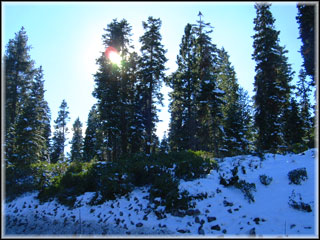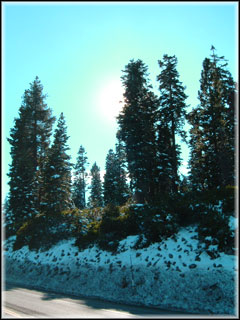The End is Just the Beginning
11.10.03

This past week, sandwiched among reports of another al-Qaeda bombing in Saudi Arabia and a particularly bloody week in US-occupied Iraq , came news of a different magnitude. New data shows that Voyager 1, NASA's 'little engine that could', may have reached the edge of our solar system, somewhere around 90 times the distance from the Earth to the Sun away from us. That's some long trip. (I can't even imagine how much legroom I'd need to sit still that many hours…)
At this 'edge', astronomers expected to find an observable energetic boundary between the solar wind (dense with particles from the Sun) and interstellar plasma (otherwise known as 'the other stuff out there'). In more basic terms, at a certain distance away, the Sun ceases to be 'the center of it all' and its sphere of influence hits a location where stronger forces (not yet fully understood by scientists) exert their power. When this boundary is crossed, we witness 'termination shock'. (Man, what a cool term!) Or at least current theories dictate this termination shock exists, though it hasn't actually been witnessed. Until now. Maybe.
Voyager recently recorded an increase in the amount of certain particles that may indicate it has reached this termination shock point. Of course, scientists disagree on the interpretation of the findings. They agree that the 'edge' is near, but can't conclusively figure out whether or not Voyager has already crossed this imaginary border. Either way, Voyager's done pretty well for a craft intended only for a relatively shorter trip to check out Jupiter and Saturn up close. Now it's traveled the furthest into space of any manmade object (that we know of) ever to leave our planet. And it's sending back data from a part of our solar system not yet explored.
Voyager left Earth in 1977, the same year in which Chiron was first discovered by astronomers. Chiron is an enigmatic body, with an identifiable tail like a comet but a much larger size similar to that of an asteroid. Some even call it a minor planet. But whatever it is, Chiron has been readily accepted into common usage by many astrologers, deeming it the most important discovery since Pluto.
Astrologically, Chiron is often described as a 'bridge' between the inner and outer planets, a description matching its eccentric orbit, which spans the vast distance between Saturn and Uranus. Chiron is the wounded healer, a symbol of our deepest physical and emotional pains and the process of combining the earth-level difficulties they cause us (Saturn) with the celestial-type liberations they promise (Uranus). In Chiron shorthand, our harshest wounds are also our greatest gifts. We are never truly flawed but always perfect and whole.
Chiron
first appeared on my website last
week, as one of the six points in my description of the past
weekend's star-of-David-shaped Harmonic
Concordance event. I must admit, until then, I'd personally
 shied away from mentioning Chiron in my practice, mainly because
my experience with it has been limited (we astrologers study the
symbols a long time before ever mentioning them to you) and
I've always tried to keep my readings and writings as simple as
possible (more symbols = more potential confusion).
shied away from mentioning Chiron in my practice, mainly because
my experience with it has been limited (we astrologers study the
symbols a long time before ever mentioning them to you) and
I've always tried to keep my readings and writings as simple as
possible (more symbols = more potential confusion).
However, any of us who wanted to discuss the Concordance were basically 'forced' to acknowledge Chiron as a symbol—because, without it, there was no six-pointed star, only a five-pointed almost-star. So, in the past few weeks, I've had to do a lot more reading and exploring of Chiron's traits and have consequently grown ever more engaged with Chiron as an astrological symbol of healing. If nothing else, this Concordance has brought Chiron a lot more press and driven many astrologers to hone our knowledge of it.
Astrologers associate the moment of a celestial body's discovery with the symbolic qualities it comes to represent in astrology, to great and useful effect. (After all, astrology rests on the idea that timing is everything.) The first major one of these discoveries was in 1781, when Uranus was first spotted by a telescope. In a single moment, the solar system as we know it doubled in size, since Uranus is twice as far from the Sun as Saturn, the furthest-away planet at that time.
Uranus's discovery coincided with a period in history marked by social revolution and the Industrial Revolution. On an accelerated time-scale, we began to create a strange and liberating new world, full of political upheavals and technological innovations that showed us a fresh perspective beyond the ordinary limits of existing structures (as represented by Saturn). This revolution continues today, and Uranus has come to symbolize radical change and the chaos it inspires, as well as the cutting edge of technology and the forces of unorthodoxy and individuality as tools for pushing the envelope. (Uranus also rules astrology.)
I'm struck by the synchronicity between last week's Concordance event, which necessitates drawing Chiron in our fold, and the news of Voyager reaching the edge of our known solar system. What I find most interesting about the astronomy of Chiron is its strange orbit, so eccentric as to vary from being within Saturn's path to going far out toward Neptune in its travels. Even more interesting is astronomers' belief that Chiron has been in this orbit for a relatively short time, entering from another unknown location, probably the Kuiper Belt, an area of similar comet-like bodies out past Neptune. Voyager has also made its way into deep space. Both Chiron and Voyager possess the promise of teaching us more about these unknown depths, their potential for revealing hints about the early life of our solar system and about what goes on past our current consciousness. And 1977 links both forever in time (along with the release of Star Wars).
It's easy to look back at the Concordance, in light of the not-surprising fact that no earth-shattering occurrence appears to have happened, as another overly hyped event produced by the wishful-thinking New Age community. After all, the promise of 'ascension' to another level of consciousness or a 'the Shift of Ages' seemed a little lofty to skeptics like myself. And yet, having experienced my own synchronicities this past week, opening my eyes to Chiron and Voyager and having reached the edge of what we know now, I'm not so sure. Maybe these lofty ideas manifest in more subtle ways than we might imagine. And maybe that subtlety will unravel as Voyager and missions beyond it continue their journeys into new regions, perhaps finding the link to other dimensions in the process, just as Chiron assists us in connecting to the transpersonal properties of the outer planets (and whatever else is out past them!).
The Moon will continue to wane, following the Concordance, toward the solar eclipse New Moon on Nov. 23. Until then, continue using its power to let things go. Admit you don't know what's next, and open your heart to that feeling. It'll take you out into deep space, where the real healing takes place.


